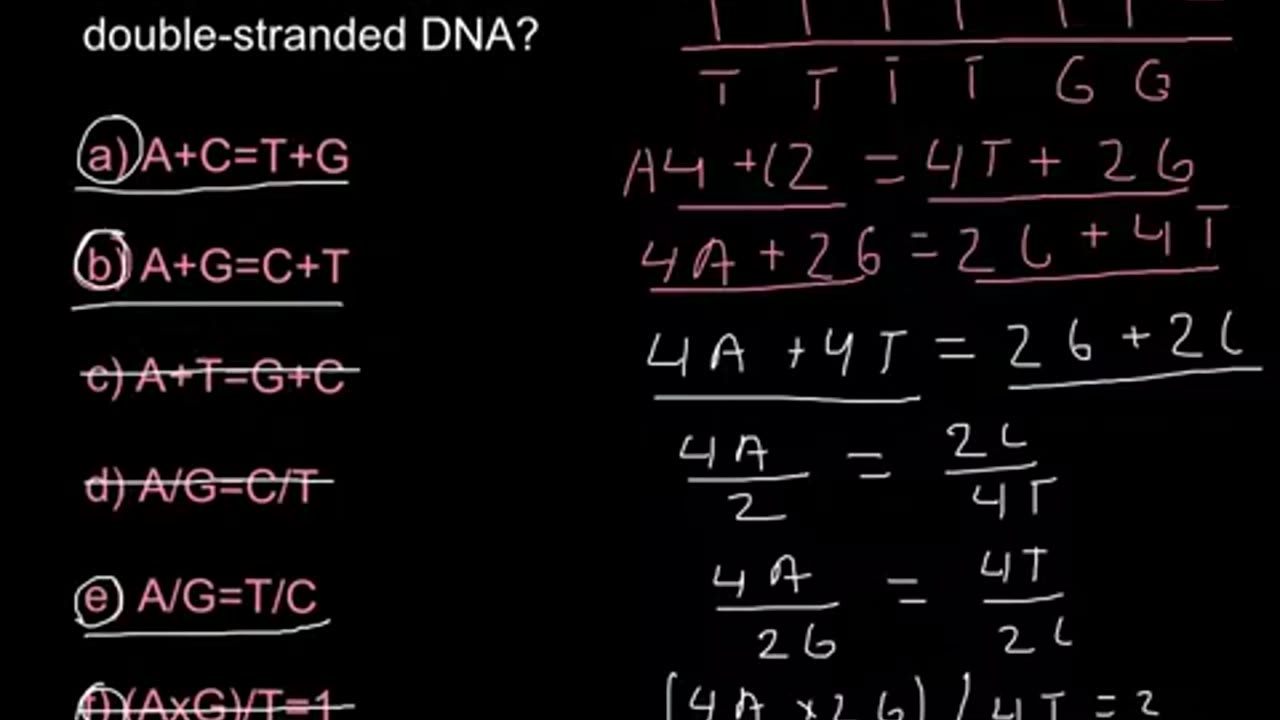Premium Only Content

Balancing DNA
Chemical analyses by scientists revealed the general chemical composition of nucleic acids (DNA and RNA): they are composed of nucleotides. A nucleotide consists of a phosphate group, a five-carbon sugar (deoxyribose in DNA and ribose in RNA), and a nitrogenous base bonded together.
Each nucleotide in a DNA molecule has one of four nitrogenous bases: adenine, guanine, thymine, and cytosine. The first two are called purine bases because their structure consists of two rings of atoms. The latter two are known as pyrimidine bases, since they have a single ring of atoms. RNA has three of the same nucleotides, but instead of thymine, RNA has uracil, another pyrimidine base. RNA will come back later, but for the remainder of this section and the next few sections, we will discuss only DNA.
Nitrogenous bases
Knowing what DNA is composed of is only half of the mystery, as scientists still could not work out the physical structure of the molecule. In the 1940s, Erwin Chargaff made an important discovery which had significant implications regarding the structure of DNA. He found that a DNA molecule contains about the same amount of adenine as thymine, and about the same amount of cytosine as guanine. This countered an earlier suggestion that the four bases existed in equal amounts in the DNA molecule.
James Watson and Francis Crick
The now famous scientists who worked out the actual structure of DNA were James Watson and Francis Crick. Their work was published in 1953. Using data from many other scientists, they deduced that the DNA molecule was arranged in the form of a double helix; that is, it looks like a twisted ladder. The sides of the ladder are composed of nucleotides with their nitrogenous bases pointed toward the center of the ladder. The rungs of the ladder are bonds between the bases on the opposite sides. To fit Chargaff's findings about the amounts of the bases in a DNA molecule, Watson and Crick suggested that adenine only forms a bond with thymine, and guanine only forms a bond with cytosine. DNA as a double helix So, if one side of the DNA molecule reads TTGACTA (we have abbreviated the names of the bases), then the other strand must read AACTGAT.
One final point about DNA's structure is that the opposite sides of the helix are said to be antiparallel. That means that they run in opposite directions. At the very end of each side of the molecule is, of course, a nucleotide. At one end, the phosphate group is the very last molecule, while at the other end, the sugar molecule is the last one. Scientists have dubbed the end with the phosphate group the 5' end (read "five prime"), and the end with the sugar the 3' end. Since the sides of the helix are antiparallel, the 3' end on one side of the ladder is opposite the 5' end on the other side.
-
 2:24:08
2:24:08
WeAreChange
4 hours agoElon Musk & Donald Trump: The Emergency Halt That Saved Us
43.6K22 -
 LIVE
LIVE
Flyover Conservatives
20 hours agoWARNING! Is Bitcoin CIA-Controlled? – The Shocking Reality of Digital Assets - Clay Clark | FOC Show
442 watching -
 LIVE
LIVE
Space Ice
7 hours agoSpace Ice & Redeye Try To Figure Out Seagal's Most Incoherent Movie
468 watching -
 1:00:36
1:00:36
PMG
21 hours ago $3.01 earned"Santa Trump is Giving Us Hope - But Will Johnson Stand Strong?"
30.2K6 -
 54:30
54:30
LFA TV
1 day agoThe German Strongman’s Arrival Is Imminent | Trumpet Daily 12.18.24 7PM EST
29.6K2 -
 2:04:11
2:04:11
Melonie Mac
5 hours agoGo Boom Live Ep 32! Soul Reaver Remastered!
25.4K6 -
 39:11
39:11
Sarah Westall
3 hours agoDigital Slavery and Playing with Fire: Money, Banking, and the Federal Reserve w/ Tom DiLorenzo
36.8K1 -
 1:38:38
1:38:38
2 MIKES LIVE
7 hours ago2 MIKES LIVE #157 ILLEGALS, PROTESTORS AND DRONES!
24K1 -
 1:01:03
1:01:03
LFA TV
1 day agoTHE LATEST SPENDING BILL IS AN ABOMINATION! | UNGOVERNED 12.18.24 5pm EST
28.7K33 -
 1:43:34
1:43:34
Redacted News
6 hours agoBREAKING! WARMONGERS PUSHING TRUMP TO LAUNCH PRE-EMPTIVE WAR WITH IRAN | Redacted News
134K228